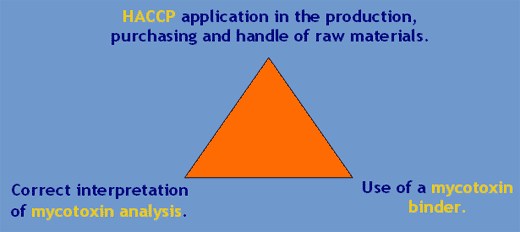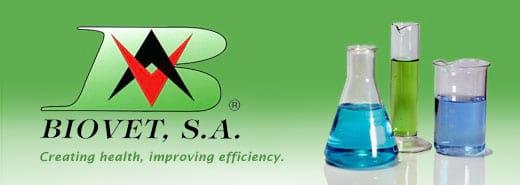mycotoxin's analysis in feed
Interpretation of the results of mycotoxin's analysis in feed
- Mycotoxins are secondary metabolites produced by fungi present in feed.
- Mycotoxin's production depends on fungus specie and strand, plant specie, environmental moisture and temperature, presence of pests, etc.
- Mycotoxins cause damages in feed quality.
- Their incidence depends on geographical area and season.
- Mycotoxins are toxic: they produce mycotoxicosis and drop of performance.
- Their presence in feed can be reduced by applying Hazard Analysis and Critical Control Points.

Mycotoxin toxicity
Main factors that influence toxicity of mycotoxins are:
- Bioavailability.
- Combined effects between several mycotoxins.
- Amount of mycotoxins consumed. Continuous or intermittent ingestion of the contaminated feed.
- Animal weight, age, physiological and health status.
Mycotoxicosis
- Mycotoxicosis (1962, Forgacs and Carl): host's intoxication as a result of ingestion of a toxic substance of fungal origin.Some cases show evident symptoms that can be easily associated to mycotoxicosis.
- In the other hand, subclinical mycotoxicosis is only recognizable by drop of performance and health status.
- Susceptibility to mycotoxicosis depends on animal specie, age, sex and coexistence with other illness.
Mycotoxicosis can cause:
| NUTRITIONAL ASPECTS | HEALTH ASPECTS | |
| Feed consume decrease. Nutrient absorption decrease. |  | Mycotoxicosis typical of every mycotoxin. Immunosupression: arise of other pathologies. |

MYCOTOXINS CLASSIFICATION AND MODE OF ACTION
- Lots of described mycotoxins.
- Varied molecular weights and structures: difficult to classify.
- They keep associated to fungus or substrate.
- Many of them are stable to chemical/physical treatments.
| Mycotoxins persist in food chain. |
Classification according to pathology
Hepatotoxins: sporidesmine, aflatoxins, luteoskirin, cycloclorotin, rubratoxins, sterigmatocistin.
Nephrotoxins: ochratoxin, citrinin.
Neurotoxins: penitrem A, patulin, fumonisins, citreoviridin.
Toxins of intestinal tract: trichotecenes, T-2 toxin, deoxynivalenol (Don, Vomitoxin), HT2 toxin, fusarenone.
Steroidal; strogenic (Zearalenone), D vitamin analogous
Haemorrhagic and circulatory toxins: Ergot alkaloids, aflatoxins.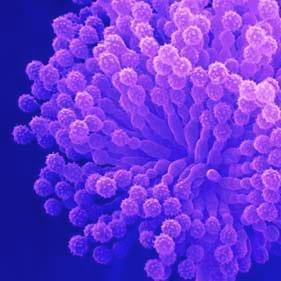
Classification according to chemical structure
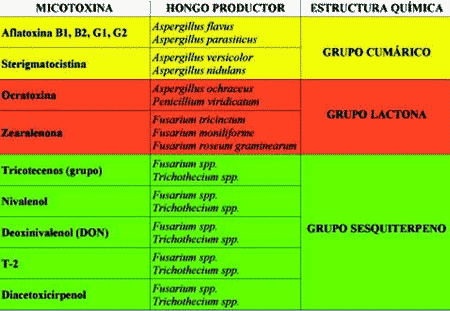
Chemical structure
Chemical structure determines:
- Mycotoxin's mode of action.
- Mycotoxin's method of detoxification.
Chemical structure and mode of action
Mode of action: specific biochemical interaction through which a substance produces its biological effect.
In order to achieve a biological effect, an interaction with a receptor is essential. 
Chemical structure and mode of action
Chemical groups of the receptor must interact with chemical groups of the substance, that is, chemical structures in the binding point must be complementary.
KEY-LOCK MODEL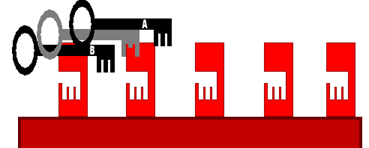

Mycotoxins with shared chemical structure may interact with the same receptors an thus have an alike biological effect.
Chemical structure and mode of action
Into practice T2 toxin, HT2 toxin, deoxynivalenol, nivalenol have a sesquiterpene group in their structure and they all have necrotic effects on mucous membranes. 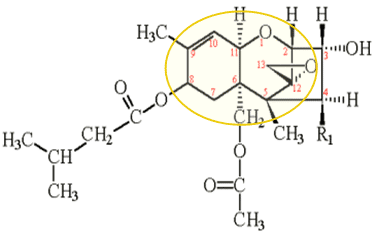
Chemical structure and mode of action
B1, B2, G1, G2 aflatoxins, sterigmatocistin have cumarinic group in their structure and they all have haemorrhagic effects alike anticoagulant active principles used in human pharmacology: warfarine, acenocumarol. These active principles also show a cumarinic structure. 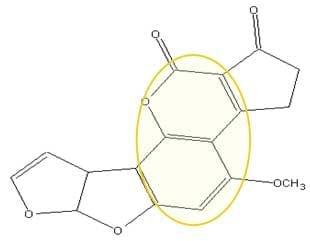
Aflatoxin B1
MYCOTOXIN ANALYSIS IN FEED MANUFACTURING
Decision making in raw material purchasing 
Usual methods of analysis
- Thin layer Chromatography (TLC).
- Liquid Chromatography (HPLC).
- Gas Chromatography-Mass spectrometry (GC-MS).
- Immunoassay(ELISA).
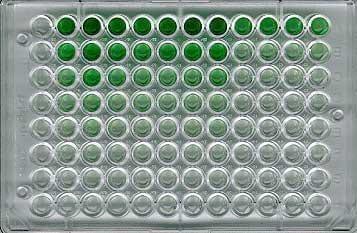
Maximum allowed concentration
Gradually more countries legislate about mycotoxin limits in fodder and raw materials destined to animal nutrition.
Maximum concentrations are set depending on:
- Mycotoxin's toxicity
- Animal specie sensitivity and age
- Fungi load characteristic of plant specie
- Availability and limits of analysis method.
Maximum concentration for each mycotoxin depends on every country.
These limits can be the reference for raw material admittance or rejection in purchasing
Maximum allowed concentration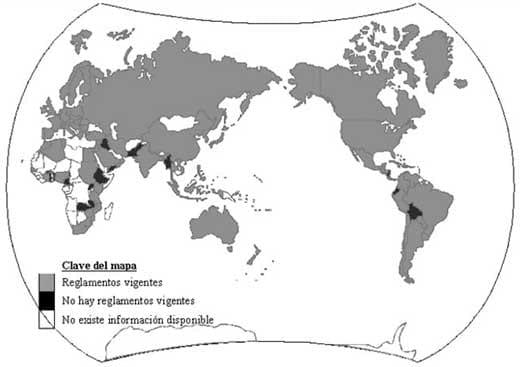

Maximum concentration depends on animal specie and age and on raw material or fodder.
INTERPRETATION OF RESULTS
Interpretation of results
Considering the results obtained in the lab, decisions are made taking into account:
- Concentration of each mycotoxin (individual effect).
- Concentration of all mycotoxins analysed as a whole (combined effects).
- Possible bias of analysis.
- Presence of non-analysed mycotoxins.

COMBINED EFFECTS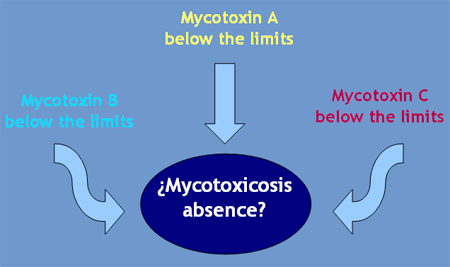
There are more possibilities of finding combined effects in mycotoxins...
- With similar molecular structure.
- Synthesized by the same fungal strand or specie.
- Synthesized by the same fungal family.
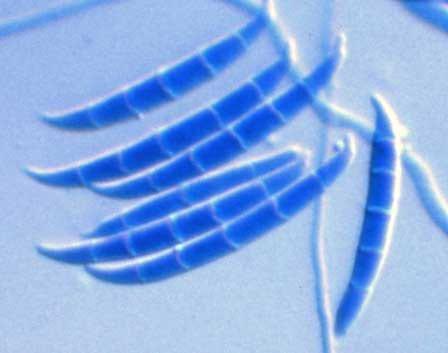
The appearance of combined effects depends on:
- Concentration of each mycotoxin.
- Animal sensitivity (specie, age, health status).

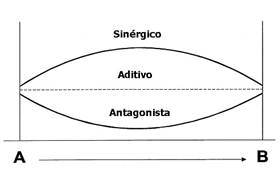
Additive effect
Combined effect of A and B mycotoxins is equal to the addition of the effect of each mycotoxins. 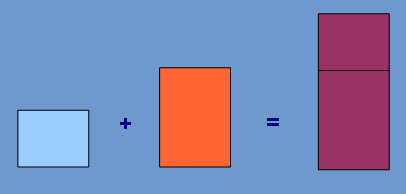
- Aflatoxins + Deoxynivalenol
Poultry: decrease in proventriculus weight, increase of DHL enzyme, indicator of tissue damage. - Aflatoxins + Cyclopiazonic acid
Poultry: growth decrease.
Pigs: feed intake and growth decrease; inflammation and necrosis of the gastrointestinal tract. - Aflatoxins + Diacetoxyscirpenol
Pig: Weight and growth decrease, alteration of blood parameters that indicates hepathotoxicity. - Aflatoxins + Moniliformin
Poultry: weight and efficiency decrease. Increase of heart's relative weight. Biochemical parameters indicate nephro and hepatotoxicity. - Fumonisin B1 + Diacetoxyscirpenol
Turkey: Weight decrease. Hepatotoxicity. - Fumonisin B1 + T-2 toxin
Poultry: weight and efficiency decrease. Nephro and hepatotoxicity. - Deoxynivalenol + Moliniformine
Turkey: weight of kidney and heart increases. Tissular damage in myocardium. - Citrinin + ochratoxin A
Pig: nephrotoxicity. They affect transport of several molecules and protein synthesis. - Fusaric
Poultry: feed consumption and growth decrease. Nephro and cardiotoxicity. - Ochratoxin A + T-2 toxin
Poultry: Weight decrease, increase of kidney, liver, proventriculus and gizzard relative weight. Nephro and hepatotoxicity.
Synergic effect
Combined effect of A and B mycotoxins is higher than the addition of the effect of each mycotoxin. 
- Aflatoxins + Ochratoxin A
Poultry: Weight decrease, mortality increase. Hepatotoxicity and severe nephrotoxicity. - Aflatoxins + Toxin T-2
 Very important because of its prevalence
Very important because of its prevalence
Poultry: weight decrease, increase of kidney, gizzard and heart relative weight; decrease of the medium corpuscular volume and of the potassium plasma levels. - Deoxynivalenol + Fumonisin B1
Pigs: great weight decrease. - Deoxynivalenol + Zearalenone
Pigs: theratogenesis in piglets.
Antagonistic effects
Combined effect of A and B mycotoxins is less than the addition of the effect of each mycotoxin. (but higher than the effect of each mycotoxin separately). 
- Citrinin + ochratoxin A
Poultry: the presence of these mycotoxins together reduces the toxic effects of the mycotoxins separately (growth and water consumption decrease). - Aflatoxins + diacetoxyscirpenol
Poultry: the presence of these myocotoxins together reduces the toxic effects of the mycotoxins separately (growth and feed consumption decrease).
BIAS OF THE ANALYTICAL METHOD
1. Not representative sampling
Sample not representative, because of the big sample size or the king of storage/container of the raw material.
2. Not validated analysis method
Analysis method should have been validated by a prestigious institution like International Organization for Standardization (ISO).
3. Low quality standards
Trouble to get mycotoxin standards in some countries.
% recovery of solid standards by dissolution <100%.
Standard solution not stable.
4. Procedure for sample extraction
5. Concentration in sample out of detection limits4.1. Influence of the extraction method:
Recovery of B1 aflatoxin using different solvents (natural contamination, results in ppb) FAO, 1994
Effect of time and extraction system for B1 aflatoxin (Natural contamination, results in ppb) using methanol-water 80:20 FAO, 1994
Limits depend on chosen analytical method.
6. Interferences with other substances present in the sample.
TLC: false positive if sample contains certain natural pigments.
TLC: false positive for B1 aflatoxin if sample contains ethoxiquin.
ELISA: false negative for aflatoxins in sorghum samples.
7. Errors in quantification.
Accuracy: is the degree of conformity of a measured or calculated quantity to its actual (true) value.
Precision: characterises the degree of mutual agreement among a series of individual measurements, values, or results.
PRESENCE OF NON-ANALYSED MYCOTOXINS
Not-analysed mycotoxins
In raw materials there could be mycotoxins whose are not analysed:
1.WELL-KNOWN MYCOTOXINS Whose analysis is not performed because of economic reasons, lack of validated methods, presence unlikely, etc.
2.LITTLE-KNOWN MYCOTOXINS Mycotoxins whose incidence and effects are little known.
THERE ARE MORE THAN 300 DESCRIBED MYCOTOXINS
Little known mycotoxins
Stachybotrotoxicosis
Stachybotrys chartarum
Caused by H satratoxin, a tricothecene 5 folds more toxic than T2 toxin.

Described in horses and human beings.
FREQUENT SYMPTOMS
Irritation and ulcers in mouth, nose, oesophagus, lips; leukopenia and agranulocytosis; fever; diarrhoea; death.
H Satratoxin

It has a sesquiterpene group in its structure and causes necrosis.
Mycotoxicosis caused by Alternaria
Alternaria spp.
Toxins secreted by Alternaria spp.: alternariol, alternariol methyl ether, altenuene and tenuazonic acid.

Described en pigs, ruminants, poultry and humans.
FREQUENT SIMPTOMS
Photosensitivity, death of the embryo, injuries in oesophagus, hepato and nephrotoxicity, diarrhoea, prostration, growth decrease, haemorrhages in muscle and lives, death.
Alternariol

Alternariol and alternariol metil-eter present cumarinic estructures and provoke hemorrhages.
Other examples:
Gliotoxin (P. terlikowskii, Trichoderma viride): photosensitivity, growth losses.
Islandotoxin (P. islandicum): Haemorrhages, hepatotoxicity.
Maltorizin (A. oryzae): muscular paralysis, hepatotoxicity. Ketomin (Chetomium cochliodes): general toxicity.
Rugulosin (P. rugulosum): cirrhosis, nephritis.
Slaframin (Rhizoctonia leguminicola): excessive salivation.
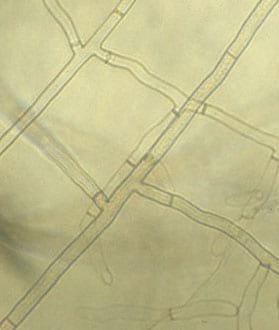
CONCLUSION
In order to avoid the mycotoxicosis, three factors must be considered:
